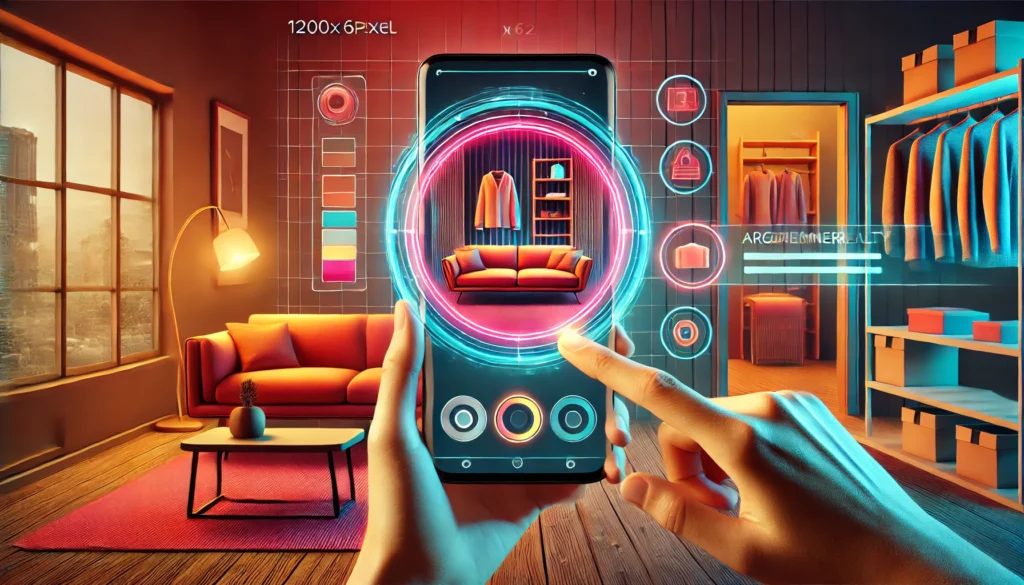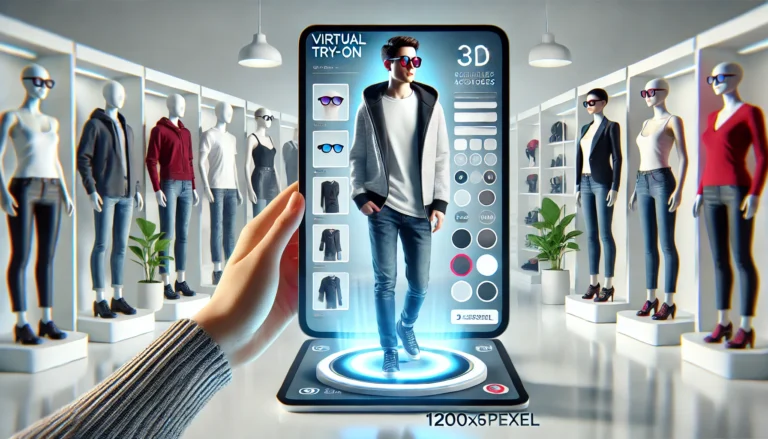Table of Contents
ToggleAugmented Reality (AR) in E-commerce: Making Online Shopping Better

Online shopping is changing fast, and augmented reality (AR) is leading the way. Imagine buying a sofa and being able to see exactly how it would look in your living room just by using your phone. AR in e-commerce 2025 is not just a cool idea; it’s becoming essential for businesses. This technology allows shoppers to interact with products like never before, offering an immersive experience that makes online shopping more engaging and trustworthy. As the digital world evolves, integrating AR into e-commerce platforms is proving to be a smart move for businesses that want to stay competitive and delight their customers. Let’s dive into how AR can make shopping more exciting, help customers, and boost sales.
1. Virtual Try-Ons: Try Before You Buy

AR lets customers try things like clothes, makeup, or glasses virtually before they buy. This feature removes much of the guesswork involved in online shopping, ensuring customers feel confident in their choices. Virtual try-ons have become a cornerstone of how AR enhances e-commerce.
How It Works: Apps like Sephora’s Virtual Artist let people test different lipstick or eyeshadow colors at home. By simply using a smartphone, users can see how products look on them in real time. These apps also allow users to save their favorite looks, making it easier to return and complete a purchase later.
Example: Warby Parker’s AR feature helps customers try on glasses virtually, so they’re more confident in their purchase. This reduces hesitation and increases satisfaction with purchases. Customers can explore multiple styles and colors to find the perfect match without visiting a store.
Why It Matters: Virtual try-ons make shopping faster and easier, especially for items like makeup, jewelry, and eyewear, where fit and appearance are critical. They also help businesses build trust by offering an accurate preview of their products, leading to better customer retention.
2. 3D Product Views: See It From Every Angle
Big purchases can feel risky online, but AR helps by showing 3D versions of products. Instead of static photos, customers can rotate and zoom in on items to examine them closely, providing a hands-on experience without needing to visit a physical store.
How It Works: Shopify’s AR tools allow businesses to make 3D models of their items, giving customers a detailed and realistic view. For businesses interested in integrating AR, tools like Shopify AR offer user-friendly solutions for creating immersive shopping experiences. These tools also integrate seamlessly with existing e-commerce platforms, making it easier for businesses to adopt. To further explore how to select the best e-commerce platform that supports AR and other advanced features, check out our guide on the best e-commerce platforms for small businesses.
Example: IKEA Place lets customers virtually place furniture in their rooms to see how it fits and looks. This tool eliminates uncertainty about size, color, and overall compatibility with existing decor. Customers can experiment with different layouts and styles, making the shopping process more interactive and enjoyable.
Why It Matters: By offering a lifelike preview, businesses can reduce customer doubts and improve conversion rates. Customers are more likely to make a purchase when they can visualize the product in their space, leading to higher satisfaction and fewer returns.
3. Personalized Shopping
AR can tailor the shopping experience to individual needs and preferences. By analyzing customer behavior and preferences, AR tools can recommend products that fit their unique style, creating a more engaging and customized shopping experience.
How It Works: AR-powered virtual stylists recommend outfits or products based on what you like. They can also suggest complementary items, creating a seamless shopping journey. These recommendations often include interactive elements, such as mix-and-match features that allow customers to build complete outfits.
Example: Nike’s AR app scans your feet to suggest the best-fitting shoes. This ensures comfort and style, addressing common pain points in online footwear shopping. The app also provides suggestions for matching accessories, encouraging customers to explore additional products.
Why It Matters: Personalized shopping enhances customer satisfaction and builds loyalty by making each user feel valued. It also increases the likelihood of repeat purchases, as customers appreciate the tailored experience.
4. Better Product Details
Sometimes photos and text aren’t enough. AR lets customers view products in detail from every angle, providing a hands-on experience without physical contact. This feature is particularly useful for complex or high-value items where every detail matters.
How It Works: AR apps provide 360-degree views of products, allowing users to see textures, materials, and features up close. These tools often include interactive hotspots that provide additional information about key features.
Example: Amazon uses AR to help customers visualize furniture or gadgets in their homes, making it easier to decide whether a product fits their needs. Customers can zoom in on details like stitching, materials, and finishes to ensure quality.
Why It Matters: Detailed product views build trust and reduce misunderstandings about quality and appearance. They also empower customers to make informed decisions, leading to fewer returns and higher satisfaction.
5. Fun Shopping Experiences
AR can turn shopping into a game, making it more interactive and memorable. Gamification can also make customers more likely to explore products and complete purchases. Adding a sense of play to shopping creates a more engaging experience that stands out.
How It Works: Retailers use AR to create treasure hunts, interactive product displays, or playful filters. These features encourage users to spend more time on their site or app, increasing the likelihood of conversion.
Example: Zara’s AR app animates clothing displays in their stores to engage shoppers and showcase products in a unique way. Customers can scan mannequins to see live-action versions of the clothing, adding a new dimension to the shopping experience.
Why It Matters: Fun experiences keep customers coming back, increasing brand loyalty and repeat business. They also encourage social sharing, helping businesses reach new audiences through word-of-mouth and social media.
6. Fewer Returns
AR helps customers make better decisions, which reduces the number of returns. By offering a clear view of how products will fit or look, businesses can minimize post-purchase dissatisfaction. Returns are costly for businesses, both financially and in terms of customer trust, so reducing them is a significant advantage.
How It Works: Virtual fitting tools ensure clothes or accessories fit before purchase. They guide users in selecting the right size and style, reducing the chances of errors.
Example: ASOS uses AR to recommend sizes, cutting down on returns. This not only saves costs but also improves environmental sustainability by reducing shipping waste. Customers appreciate the accurate sizing, which builds trust and encourages repeat purchases.
Why It Matters: Fewer returns mean happier customers and lower operational costs for businesses. It also enhances sustainability efforts, appealing to eco-conscious consumers.
7. More Customer Interaction
Interactive AR tools keep customers engaged longer, increasing the chances they’ll buy. The more time users spend exploring products, the more likely they are to make a purchase. Engagement is a key metric for e-commerce success, and AR excels at capturing attention.
How It Works: Filters and tools let people test how products look in their homes or on themselves, offering a more immersive experience. These tools often include social sharing features, allowing customers to get feedback from friends and family.
Example: Wayfair’s AR app allows users to design their rooms virtually, boosting engagement and helping customers visualize their ideal spaces. Customers can experiment with different layouts and styles, making the shopping process more interactive and enjoyable.
Why It Matters: Increased interaction leads to higher sales and stronger connections between brands and customers. It also creates opportunities for upselling and cross-selling, as customers are more likely to explore additional products.
8. Customized Experiences for Different Markets
AR can adapt shopping experiences to fit the language or culture of different regions. This allows global businesses to cater to diverse audiences, ensuring that their offerings are relevant and appealing to local markets.
How It Works: Businesses create AR overlays designed for specific markets, including localized features and designs. These overlays can include cultural elements, such as traditional patterns or regional preferences.
Example: Global brands use AR to highlight culturally relevant styles and products, helping them appeal to various demographics. For instance, a fashion brand might showcase different collections based on the season and region.
Why It Matters: Customization helps businesses build trust and appeal to international markets. It also improves the customer experience by making it more relevant and engaging.
9. Social Media Integration

AR works well with platforms like Instagram and Snapchat, making social shopping more fun. Social media is a key tool for e-commerce, and AR enhances its effectiveness by creating shareable and interactive content.
How It Works: Social media ads include AR filters that let users try products directly from their feeds. These filters often include call-to-action buttons that guide users to the product page for quick purchases.
Example: Gucci’s AR filters let users try on luxury items, such as sunglasses and shoes, without leaving Instagram. This seamless integration makes it easy for customers to shop while browsing their favorite platforms.
Why It Matters: Social media integration helps brands reach younger audiences and increase sales through shareable experiences. It also drives traffic to e-commerce sites, boosting overall visibility.
10. AR for Small Businesses
You don’t need to be a giant company to use AR. Affordable tools make it possible for smaller stores to compete and stand out. AR levels the playing field, giving small businesses a chance to offer high-quality shopping experiences.
How It Works: AR plugins for platforms like Shopify or WooCommerce are easy to use and cost-effective. These tools require minimal technical knowledge, making them accessible to businesses of all sizes.
Example: Small shops use AR to show unique items, such as handcrafted jewelry or decor, enhancing their online presence. These features attract customers who value craftsmanship and quality.
Why It Matters: AR levels the playing field, giving small businesses a competitive edge in crowded markets. It also helps them build a loyal customer base by offering innovative and engaging shopping experiences.
Wrapping It Up: AR's Game-Changing Potential
Augmented reality isn’t just a futuristic idea anymore—it’s here, and it’s transforming e-commerce in ways that were once unimaginable. AR in e-commerce 2025 offers businesses the ability to elevate customer experiences by blending the digital and physical worlds seamlessly. Whether it’s through virtual try-ons, 3D product views, or gamified shopping, AR delivers a level of interaction that keeps customers engaged and confident in their purchases. These immersive experiences not only reduce returns but also boost sales, making AR an essential tool for success in the competitive online marketplace.
If you want your business to thrive in today’s fast-evolving e-commerce landscape, now is the perfect time to embrace augmented reality. And you don’t have to navigate this alone. Partner with the experts at Chauncey Agency to unlock the full potential of AR for your online store. From strategy to implementation, we help you stay ahead of the curve and provide unmatched value to your customers. Reach out to us today and start building a future-ready e-commerce business!
FAQs (Frequently Asked Questions)
What is AR in e-commerce?
AR in e-commerce uses augmented reality to create interactive shopping experiences. It helps customers visualize products in real-world settings, making them feel more confident about their purchases.
How can small businesses afford AR?
Many AR tools, like Shopify AR or Snapchat filters, are affordable and easy to set up, even for small businesses. These tools provide a cost-effective way to offer premium shopping features.
What industries benefit most from AR?
Fashion, beauty, furniture, and electronics benefit the most, but any online store can use AR to enhance the customer experience. Even niche markets can leverage AR to connect with their audience.

